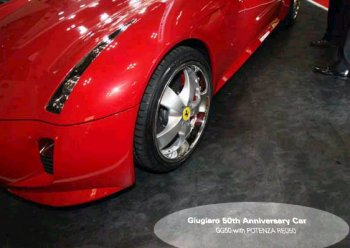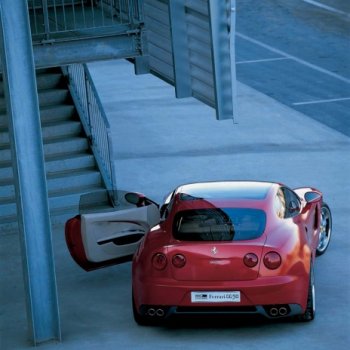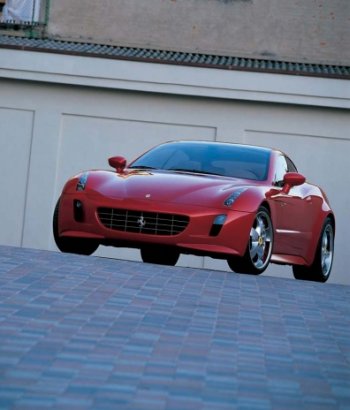|
Giorgetto
Giugiaro will show the Ferrari GG50 - a concept sportscar he
created to celebrate his 50th anniversary as a lading car
designer - to a world wide audience when it appears at the
Geneva Motor Show later this month. Unveiled in association
with Bridgestone at the Tokyo International Motor Show last
October it was on of the Japanese show's star attractions.
Based around the Ferrari 612 Scaglietti, as directly
requested by Ferrari President Luca di Montezemolo, the GG50
is a fully working and viable sportscar, which effectively
and visually embodies Giugiaro's traditional styling
trademarks.
Giorgetto
Giugiaro painted in glowing colours this great adventure
last autumn: “To mark 50 years of activity in the world of car design, I
decided to sculpture a Ferrari to the memory of that great
adventure and enjoy it with my family”. Giorgetto Giugiaro
fashioned and commissioned a project that spilled into
stretching horizons, in that he became concurrently – for
the first time ever – supplier and customer of the new car.
Rather than being a spellbound step into tomorrow, the
ultimate outcome of all this is an expression of today – a
Ferrari graced by his initials, GG, followed by the digit 50
by way of epitomizing his debut into the world of car design
in September 1955 – imbued by an imposing, unmistakable
artistry capturing skyhigh ergonomics and outstanding space
on board.
Created along the lines of the Ferrari 612 Scaglietti, and
retaining the same basic mechanics, the Ferrari GG50 is a
little shorter in length than the original model, with a
fastback tail conspired to conceal the underlying hatchback
lid. The rear seatbacks can be folded down to create, thanks
to the new fuel tank, a flat trunk platform one meter and 40
centimeters deep. All that was checked and verified with the
Ferrari Technical Direction support.
The idea of creating a Ferrari to mark 50 years of activity
in the world of car design took shape in September 2004 at
the Paris Motorshow, where Giorgetto Giugiaro talked about
this flight of fantasy directly with the President and CEO
of Ferrari Luca di Montezemolo who cued the model around
which the vehicle concept should be developed: the 612
Scaglietti 12 cylinder four-seater coupé.
Montezemolo also gave Giugiaro two inputs: although no
restrictions would be posed on creative-thinking, the
vehicle must be perfectly in keeping with the Ferrari
tradition and transmit a sensation of compactness, even
being highly enjoyable. Giugiaro started to work on the
project in February 2005, sketching entirely by hand – a
practice followed over the last 50 years – the physical
design of the vehicle in 1:10 scale from four orthogonal
views, marking out the side, nose, tail and bird’s view: all
sketched in 2H lead pencil on tracing paper using a
universal chalkboard.
This two-dimensional rendering is typical of Giugiaro's
method and is today pursued by Fabrizio Giugiaro, Italdesign
Giugiaro Styling Area Director. According to this procedure,
the rendering is translated into math surfaces in order to
proceed to a 3D validation of the project by means of 1:1
scale dynamic visualization in the Italdesign-Giugiaro
Virtual Reality Design Centre.
Once the Virtual Reality green light was given, seeing onset
was full-scale plaster model milling, as duly completed in
April. Along with the 1.1 scale mock-up model put in place
to test out the ergonomics and ease-of-access interior
concepts, starting to undergo construction at the beginning of June was
the running prototype.
Retaining the wheelbase at 2.95 meters, the Ferrari GG50
spans 4 meters and 81 centimetres in length vs.4.90 for the
Scaglietti. Giorgetto Giugiaro reinterpreted the front just
a little, pruning the front overhang by 2 centimetres. On
the other hand, he revolutionized the rear section, nipping
the overall length of the car by 9 centimetres. In the
Scaglietti, the fuel tank is positioned vertically, behind
the rear seating. For the Ferrari GG50, Italdesign engineers
were asked by Giugiaro to concentrate on positioning the new
95-liter fuel tank entirely below the trunk platform line.
With the rear seatbacks folded down, the redesigned fuel
tank layout translates into a flat trunk platform one meter
and 40 centimetres deep. Compared to the 240-liter loading
capacity of the Scaglietti, the loading capacity offered by
the GG50 stretches to 270 litres, which, with the rear
seatbacks folded down, increases to 500 litres. In a
strategic intent to take full advantage of the bolt-on
loading space driven through by the new fuel tank layout,
Giorgetto Giugiaro decided to use a proper hatchback lid
which is hinged to
the roof’s edge.
From a structural standpoint, Italdesign engineers had to
redesign the rear cross-member which, in the Scaglietti,
joins the suspension domes atop the fuel tank. Likewise,
also added to the roof’s edge was a cross-member, joined to
two reinforced risers, to stand the hatchback trunklid’s
weight.
|
 |
|
First unveiled at the 39th Tokyo
Motor Show last October, the Italdesign-Giugiaro Ferrari
GG50 was
definitely one of the biggest stars of the Japanese show. |
|
 |
|
 |
|
The idea of creating a Ferrari to mark 50 years of activity
in the world of car design took shape in September 2004 at
the Paris Motorshow, where Giorgetto Giugiaro talked about
this flight of fantasy directly with the President and CEO
of Ferrari Luca di Montezemolo who cued the model around
which the vehicle concept should be developed: the 612
Scaglietti 12 cylinders four-seater coupé. |
|
|
 |
|
"To mark 50 years of activity in the world of car
design, I decided to sculpture a Ferrari to the
memory of that great adventure and enjoy it with my
family," said the Ferrari GG50's creator, Giorgetto
Giugiaro. |
|
|
The more instantly recognisable makeover is the
tail’s sleeker shape, where the rear profile has been nipped
7 centimetres.
Although being 9 centimetres shorter than the Scaglietti,
the Ferrari GG50 appears instantly to be even more compact
than the series-production car as a result of the subtly
rounded nose and tail angles. “In bird’s view, all cars look
like a rectangle”, explains Giugiaro. “As a consequence, the
dimensions are perceived optically as being the same as the
maximum length”. In the GG50, however, Giugiaro rounded to
an extreme the loop between the cowl and the front
wheelhouse, applying the same treatment to the rear.
“When viewed three-quarterwise, this also enhances the look
of the car optically, making the car appear leaner and
bolder. In a nutshell, rather than having a fender lip that
clearly defines the bodyside edge, a seamless line flows
toward the centrepoint where the two extremities meet”. From
a structural architecture standpoint, the GG50 relinquishes
the
Scaglietti’s third compartment for a nimbler tail, an
instantly recognisable fastback. A very bold statement of
performance and design is the general impression perceived.
A compact coupé, ready to bite the grit, with the rear seats
so well concealed as to be perceived as a classic
two-seater. The bodyside is immaculate. The air intake –
providing cool air for front brake system cooling – meanders
along almost in parallel with the ground line and creates a
bas-relief that fades into the rear.
As for the more stunning Ferrari cars, the belt line arches
in correspondence to the rear wheel highlighting the
generous wheelhouse’s taut muscle. The boldly tapered rear
profile gains form and shape from the side view, in that
emerging from the tail-end mirror are the dual tail lamps,
which, of course, are round. Absolute simplicity in the
front as well. With the low-slung Ferrari grille looking
just as fresh and fun loving as ever, the nose flares
forward in the centre with two generous and vertical air
intakes unfolding to the side, where the fog lights are
housed. The headlamps are vertical, a stroke of pen that
translates into a black crescent moon housing XENON
headlight beams and dimmers, and the turn
signal indicators. The long bonnet is creased almost
imperceptibly by a V, which makes the volume more plastic
without, however, disrupting the natural flow of the lines.
Likewise simple is the tail, with the lower section, housing
the chrome dual exhausts, black-painted to reduce the
overall sensation of height. Incorporating LED technology,
the round dual lamps are asymmetric, with those to the side
playing a master role. Set at the forefront, the chrome
Prancing Horse. The crest of the trunk rises towards the
center contouring a small spoiler to provide extra downforce
at the rear and insure the car is stable at high speeds.
Practically imperceptible is the hatchback door. The GG50
seems to have a classic trunklid hinged under the rear
window. However, the rear window as a whole lifts up along
with the trunklid and, as such, is a proper hatchback door.
In bird’s view, the elements that dominate are two: the
boldly tapered four extremities and the photochromic roof,
which, with the fender, creates a seamless transparent
surface.
Whilst the GG50’s exterior drew breath from a universal
chalkboard, its interior was fashioned as the mock-up
progressed. In addition to retaining as mentioned earlier
the wheelbase, also retained was the interior appearance of
the Scaglietti. However, when working on the fullsize
mock-up, Giugiaro and his son Fabrizio, decided to eliminate
the closed-in feeling back in there by sloping the rear
window at the side. “Getting in and out of a 2+2 coupé is
never an easy feat, because access is directly proportional
to the door’s length, which cannot be stretched to the
infinite. Indeed, the GG50 door’s structural frame
mesmerizes the Scaglietti’s door framework. However,
enhanced headroom has been gained by sloping the rear
window, thereby making it much easier to get in and out of
the car than expected. Just try getting in and out of the
car and you’ll see how easy all this can be”, explains
Giugiaro. One other thought of mind went to the driver’s
right hand. Used by tradition to change gear, drivers do not
use their right hand as much as before due to the F1 gear
change fitted on the steering wheel. As such, repositioned
to the right-hand side of the dashboard are certain commands
and controls once found by tradition on the left-hand side,
such as the lights and, not least, the handbrake, in this
exercise, electric. Taken as a whole, the instrumentation is
the same as the one to be found in the series-production
car. Brand new is the dashboard, fitted in the centre of
which is the AVIC – X1R satellite navigator by Pioneer.
Fitted inside the central console, whether between the front
or rear seats, are two generous storage pockets, duly
protected by a flap. Decidedly unusual for a Ferrari in
these times, the door panels, featuring a large glovebox,
have a horizontal natural beech insert. Covered in beige
leather, the seats use the structural frames found in the
production car. The upper section of the rear seatbacks can
be folded down, thereby creating a flat loading platform at
the same height as the new fuel tank.
Ferrari GG 50 Technical Specification:
Dimensions:
Length 4,810 mm; Width 1,950 mm; Height 1,347 mm; Wheelbase
2,950 mm; Front track 1,677 mm; Rear track 1,643 mm; Front
overhang 838 mm; Rear overhang 1,022 mm; Trunk Size: 270
litres; Trunk Size with rear seats folded down 500 litres;
Engine: V12 – 5,748 cc; BHP (bhp/rpm) 540NHP at 7250;
Drivetrain: Rear-wheel drive; Transmission: 6-speed
automatic with sequential mode; Front Tyres: Bridgestone 245
35 ZR20; Rear Tyres: Bridgestone 305 35 ZR20; Brakes: Brembo;
Wheels: ATP Tecnoforming 20-inch; Colour: Red
|
|
|
|
![]()
![]()